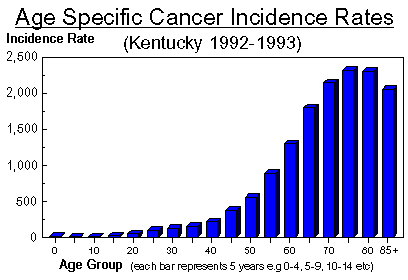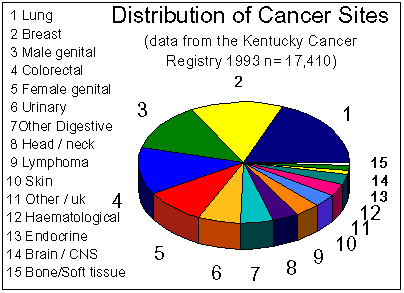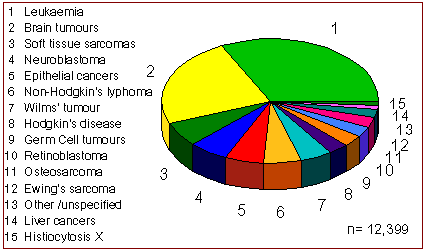About Cancer
 What is Cancer ?
What is Cancer ? Adult Cancers
Adult Cancers Childhood Cancers
Childhood Cancers Cancer - a global problem
Cancer - a global problemWhat is Cancer ?
When the body's cells become abnormal and duplicate out of control a tumour is formed, these may be cancerous (spreading) or benign (non-cancerous). Normal body cells divide in a controlled and relativly slow rate, in malignant cells the duplication is uncontrolled and often at a very rapid rate. If the tumour (also refered to as a growth or neoplasm) is malignant (spreading) the disease may develop in other parts of the body where secondary tumours may form (known as metastasis).
Cancer is not a single disease but a wide range of different diseases of which there well over a hundred types. Cancers can be classified into two broad types: haematological (malignancies of the blood) or solid tumours. The name of the cancer depends on the type of tissue and/or site it develops in. For example a sarcoma is a cancer arising from bone, muscle or connective tissue, and carcinoma is cancer arising from epithelial tissue (cells of the glands and the outer layer of skin that lines blood vessels, hollow organs and the body's orifices).
What causes cancer ? The cause of most cancers remains unknown. A minority of cancers are known to be hereditary (inherited). For example some breast cancers, retinoblastomas, and Wilms' tumours are thought to be hereditary. In rare cases the family may have a history of cancers (Li-Fraumeni Syndrome) [1]. However most cancers have no obvious hereditary cause. Carcinogens are chemicals or enviromnental factors that may cause normal cells to become abnormal and cancerous by damage or mutate a cells genetic material (DNA and RNA). For example smoking is known to increase a persons risk of lung cancer, likewise over-exposure to ultraviolet sun light increases the risk of melanoma, and inhilation of asbestos dust can cause mesophelioma (cancer of the lining of the lungs). Some viruses are known to be carcinogens, for example the HTLV-1 virus is associated with leukaemia. Radiation exposure has also been linked with cancer incidence. Other factors such as diet and excercise may influence cancer incidence.
One or more 'insults' (exposure to carcinogens) may result in damage or modifications to a cells DNA. Oncogenes are genes present in the DNA of every cell and carry out normal functions but have the potential to make a normal cell turn cancerous. These genes help regulate normal growth and development, but an abnormal change may cause them to produce irregular or excessive amounts of chemical signals. These may stimulate extreme or abnormal cell growth. On the other hand some genes are thought to be protective against cancer and viruses causing badly damaged cells to self-destruct (apoptosis). If these such genes are damaged or absent then the risk of cancer may increase. For example deletion of the P53 gene has been identified in a range of cancers.
 Guide to Medical Terminology for Cancer
Guide to Medical Terminology for Cancer
Adult Cancers
More than one in four people will have cancer during their lifetime, and after heart disease cancer is now the most common cause of death in western countries. [7] Adult cancer is a diverse range of different diseases. The chart below shows the distribution of different cancer sites (male and female combined) from Kentucky (USA) in 1993 based on data provided by the Kentucky Cancer Registry [8].
The incidence and types of cancer varies between and also within different countries. It will depend on demographic (population), environmental and other factors. For example there are differences in cancer incidence between different racial groups, diet and climate may also influence cancer incidence [9]. In particular the age distribution of the population will influence the incidence of different types of cancer. The peak incidence of many adult cancers is after the age of 45 (eg. lung, breast and prostate cancer). Other cancers such as bone tumours, Hodgkin's disease, and cervical cancer are more common in younger adults. Leukaemia is found in people of all ages and is one of the most common type of cancers in adults aged under 35. Age specific cancer incidence rates are shown below (for all types of cancer combined).

Cancers can arise in different parts of the body. lung cancer is one of the most common cancers in both men and women, and smoking is known to increase a persons risk for this disease. cancers associated with the digestive system include colorectal cancer (colon / rectum) and cancers of the pancreas, stomach, esophagus, and other organs. Haematological malignancies (cancers of the blood, plasma and marrow) include leukaemia and myelomas. Lymphomas are classified as either Hodgkin's or non-Hodgkin's Lymphoma. Thyroid cancer is the most common type of tumour in the endocrine system (hormones), while brain and spinal tumours are found in the central nervous system. Associated with the urinary system are bladder and kidney cancers. Sarcomas (bone, soft tissue, or connective tissue tumours) are related to the musculoskeletal system. Skin cancers include melanoma and basal cell carcinoma. Head and neck cancers include those of the oral and nasal cavities.
Some cancers are particular to men and women. Breast cancer is one of the most common neoplasms, predominantly found in women (1% are in males). Associated with the female reproductive system are cervical, ovarian, and other genealogical cancers. In men prostate cancer is one of the major neoplasms, other cancers of the male reproductive system include testis and penile cancer.
Childhood Cancers
Childhood cancer is rare, about 1 in every 600 children aged under 15 develop cancer, still very little is known about it's causes [2]. Compared with adult cancers they tend to have different histologies and occur in different sites of the body [3]. Common adult cancers such as lung, breast, colon, and stomach are extremely rare among children. On the other hand some types of cancer are almost exclusively found in children, especially embryonal tumours which arise from cells associated with the foetus, embryo, and early postnatal period. Treating children requires different considerations compared with adult oncology, for example potential treatment side effects may be different to those in adults. Because of these differences between childhood and adult cancers most children are treated in specialist paediatric oncology units, in the UK about 80% of children are treated at a UKCCSG centre. The overall cure rate for childhood cancer has drastically improved over the last 2 decades in association with clinical trials and the development of new treatments [4,5].
The chart above shows the proportions of different cancers in childhood based on UK data from The National Registry of Childhood Tumours [6], the number for histiocytosis was estimated by using the same proportion as in the American SEER data [3].
Leukaemia is the most common type of childhood cancer, representing about one third of all cancers in under 15 year olds. Leukaemia is a condition where too may underdeveloped white blood cells are found in the blood and bone marrow. Four fifths of childhood leukaemia's are acute lymphatic leukaemias (ALL), other types include acute myeloid leukaemia (AML) and chronic myeloid leukaemia (CML). Brain tumours are the most common solid tumours in childhood, and make up about a fifth of all children's cancers. There are many different types of brain tumours; medulloblastoma, astrocytoma and brainstem glioma are the most common.
Neuroblastoma (sympathetic nervous system), retinoblastoma (eye), Wilms' tumour (kidneys), and hepatobalstoma (liver) are most usually found in infants or young children. Other malignancies found in children and young adults include Lymphomas (Hodgkin's and Non-Hodgkins lymphoma), soft tissue sarcomas (including rhabdomyosarcoma), bone cancer (osteosarcoma and Ewing's sarcoma), plus a number of less common childhood cancers. Histiocytocis is rare; it is not a true cancer, but in many respects behaves like one.
Cancer - a global problem
Data from the World Health Organisation [10]
- In 1997, a world-wide total of 6.2 million deaths were due to cancer (out of a total of 52.2 million deaths). Leading causes of death from cancers were those of the lung (1.1 million), stomach (765 000), colon and rectum (525 000) liver, (505 000), and breast (385 000).
- Cancer and cardiovascular (heart) disease are the leading causes of death in industrialised countries, in developing countries infectious diseases are the most frequent cause of death.
- By 2025 the risk of cancer will continue to increase in developing countries, with stable and possibly declining rates in industrialized countries (partly due to screening).
- World-wide cases and deaths of lung cancer and colorectal cancer will increase, largely due to smoking and unhealthy diet respectively. Lung cancer deaths among women will rise in virtually all industrialized countries, but stomach cancer will become less common generally, mainly because of improved food conservation, dietary changes and declining related infection.
- Cervical cancer is expected to decrease further in industrialized countries due to screening. The incidence is almost four times greater in the developing world. The possible advent of a vaccine would greatly benefit both the developed and developing countries.
- Liver cancer will decrease because of the results of current and future immunization against the hepatitis B virus in many countries
References and information sources
1. Birch JM. Li-Frameni Syndrome. Eur. J. Cancer 1994;30A:1935-41. back to text
2. Stiller CA. Aetiology and epidemiology. In Plowman PN, Pinkerton CR, Paediatric Oncology: Clinical practice and controversies. Chapman and Hall Medical 1992. back to text
3. Miller RW, Young JL, Novakovic PH. Childhood Cancer. Cancer 1994;75:395-405. back to text
4. Lukens JN. Progress Resulting from Clinical Trials: Solid Tumours in Childhood Cancer. Cancer 1994;74:2710-8 back to text
5. Draper G, Kroll ME, Stiller C. Childhood Cancer. In: Trends in Cancer Incidence and Mortality. Cancer Surveys 1994;19,493-517. back to text
6. Stiller CA, Allen MB, Eatock EM. Childhood Cancer in Britain: The National Registry of Childhood Tumours and Incidence Rates 1978-1987. European Journal of Cancer 1995; 31A:2028-2034. back to text
7. Prescott DM, Flexrer AS. Cancer - The Misguided Cell. Second Edition. Sinauer Publishers (1986) back to text
8. The Kentucky Cancer Registry 1993 Cancer Incidence Report. URL http://web.kcr.uky.edu. back to text
9. Miller AB, Berrino F et al. Diet in the Aetiology of Cancer: a Review. Eur. J. Cancer 1994;30A:207-220. back to text
10. World Health Organisation - World Health Report 1998 back to text


 Childhood Cancer Resources
Childhood Cancer Resources